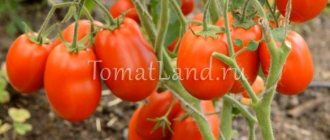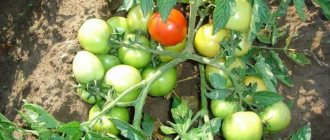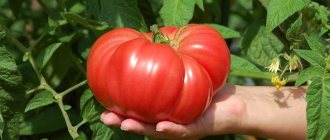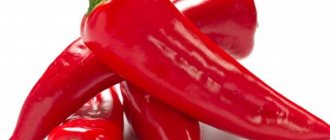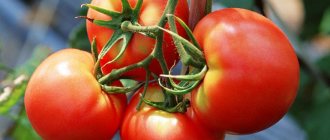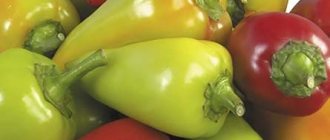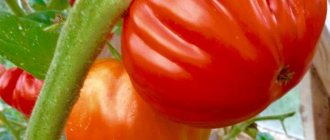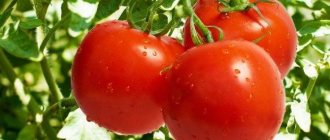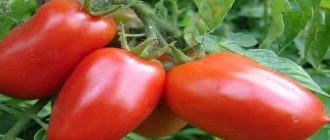» Vegetable growing » Tomatoes » Tomato variety Giraffe
0
1575
Article rating
At one time, the Giraffe tomato made a splash in the vegetable growing community. The fact is that breeders, in an attempt to create a frost-resistant plant, managed to instill the flounder gene into the tomato. It got its name for two features: the color of the skin, which varies from yellow to orange, and the shelf life - the fruits can last up to six months (a reference to the long neck of the animal).
- Advantages and disadvantages
- Features of cultivation
- Landing
- Care
- Errors during cultivation
- Reviews from gardeners
Tomato variety Giraffe
general description
Giraffe is a varietal tomato. It received this name for the height of the bushes, which reaches 2 m. The seeds of the fruits of this tomato are suitable for planting.
Relatively recently, this variety was at the peak of popularity, which is due to the unusual origin of the Giraffe. When creating it, breeders used the flounder gene. This was done to increase the frost resistance of the plant, but the experiment gave an unexpected result - the variety received exceptional keeping quality.
Attention! The Giraffe variety belongs to genetically modified plants. It is not yet known how dangerous GMO tomatoes are. Some scientists believe that such products can cause infertility, mutations in offspring, etc. Others claim that GMOs are absolutely safe.
Distinctive features of the variety
The main feature of Giraffe tomatoes is their high keeping quality. The fruits of this variety are stored in boxes all winter, until March 8.
Giraffe fruits are dark yellow. Lighter spots may be present. The pulp is different from the shell and has an orange-pink color.
This shade of berries is ensured by the high content of beta-carotene. This substance has a positive effect on visual acuity, skin and hair condition, and the immune system. Doctors note the fact that yellow-fruited tomatoes are less likely to cause an allergic reaction than red-fruited ones. They contain less purines.
General characteristics
Now the popularity of the Giraffe tomato has subsided somewhat, because the process of its creation causes mixed reactions among people. But this variety still has fans, which is explained by its unique characteristics.
Characteristics and description of the variety:
| Parameter | Indicators |
| Bush type | Indeterminate. It reaches a height of 2 m. The stems are strong and powerful. The bushes are covered with an average number of leaves, are not spreading and do not form very many stepsons. The leaves are simple, light green, without pubescence, and medium in size. The inflorescences are also simple. The first is formed at the level of 7-9 leaves, the next ones - after 2 leaves. The fruits are formed in clusters of 5-7 pieces. on each one. Up to 10 brushes are formed on one bush. |
| Growing method | Tomato is resistant to negative environmental factors. Suitable for growing in greenhouses and open ground. |
| Productivity | High. 5 kg of berries are harvested from 1 bush per season. From 1 sq. m yield about 15 kg of fruit. |
| Fruit | Medium size. The average weight of one berry is 80-100 g. Specimens weighing 150 g are rare. The color of the shell is dark yellow. There may be light yellow spots. The inside of the fruit is orange-pink, with lighter spots possible. The shape of the berries is round, sometimes slightly elongated. There is pronounced ribbing at the base. The pulp is dense, not very juicy, tough. The fruit tastes sweet and sour. Inside each berry there are 3-4 chambers with a large number of seeds. |
| Transportability | The fruits have a thick skin, which protects them from damage during transportation. Tomatoes collected at the stage of technical maturity are stored in boxes for up to 6 months. |
| Ripening time | Late ripening variety. The fruits ripen in mid-August. Fruiting continues for 1.5 months. |
| Disease resistance | It is immune to viral diseases: tobacco mosaic, brown spot and brown rot. There is no resistance to late blight. |
Tomato Ildi: characteristics and description of the variety with photos
Fans of small-fruited tomato varieties will certainly appreciate the Ildi tomato. After all, it is a decoration for any area and holiday table, including.
What is the species
The characteristics of the plant will help you understand what is necessary for the proper growth of tomatoes on the site, their fruiting and the prevention of diseases.
https://youtube.com/watch?v=VOkQChzGJkc
Plant:
- Bush: indeterminate.
- Height: 1.8-1.9 m.
- Brushes: fan, complex. The first is laid over the 9th sheet.
- Number of tomatoes in a brush: 50-70 pcs.
- Ripening time: 85-100 days.
Fruit:
- Shape: round.
- Yellow color.
- Weight: from 10 to 15 g.
- Density: high.
- Peel: not tough.
- Taste: sweet.
- Transportability: excellent.
- Shelf life: long time.
Planting and care
By growing an “Ildi” tomato on your plot, you can surprise all your friends and acquaintances. A plant with tassels that live their own lives. On a separate cluster, fruits can grow and turn yellow, bloom, and produce a new crop at the same time.
The seeds are small, so they take a long time to enter, up to 14 days.
They are grown in open ground and in greenhouses. It is best to place 3 plants per 1m2. Form into 2-3 stems. After the formation of 4-5 brushes, the growth point is removed. This is necessary so that the plant gives more strength to the existing fruits.
Stepping is mandatory, especially the first time after planting in the ground.
Susceptibility to diseases. Harvest volume and application
Resistant to many diseases. Including late blight. There is no need for special treatment of seeds and adult tomato plants.
The productivity is high; with proper formation of the plant, you can get a rich harvest of tomatoes of the same size. Approximately 3 kg per plant.
Positive and negative aspects of the species
"Ildi", a tomato that has more positive characteristics. Therefore, it is appreciated by lovers of Cherry tomatoes.
Pros:
- Hardy.
- Resistant to diseases. In particular late blight.
- High yield.
- The versatility of fruit use.
- Long shelf life.
- The fruits do not crack.
- Favorite treat for children.
Minuses:
- Mandatory bush formation.
- Each brush needs to be tied individually, and there can be up to 10 pieces.
The opinion of summer residents regarding Ildi tomatoes
Useful information about the characteristics of the variety is available on the Internet. By studying reviews, you can obtain information about the subtleties and agrotechnical techniques, taking into account which will help you grow a healthy bush and reap a large harvest.
Marina. Delighted with the plant. Fruiting is long, until October. The taste is sweet.
Zoya. The description coincided with reality. They sing before everyone else.
Alexandra. I liked the high yield volumes and taste. Survived the frosts in June. It has become the undoubted leader on the list of mandatory landings.
Hope. Delighted with tomatoes, a tall plant laden with fruits. The taste is amazing, the skin is not rough, but not thin either. There are more advantages regarding similar tomato varieties. Wins in terms of taste and harvest volume.
Meleja. This is the second year he has been growing tomatoes of the “Ildi” variety. He says that for a family of 4 people, 2 plants are enough. If not canned. The first year I tried to stop the growth of the brush, cutting off the excess, thereby reducing the volume of the harvest. Formed the plant into one trunk.
Small-fruited tomatoes of the “Ildi” variety are gaining more and more recognition among summer residents. For its taste and ability to decorate any area.
How to grow seedlings
For seedlings, Giraffe tomato seeds are sown 2 months before planting the plants in a permanent place. The lower the temperature in the region, the later they begin to grow seedlings.
Before sowing seeds, gardeners recommend familiarizing yourself with the lunar calendar. Experience in growing tomatoes shows that plants planted on the correct lunar day grow healthier and produce a bountiful harvest.
Processing of planting material
Tomato seeds need to be prepared before planting.
This will prevent future infection of plants, increase their resistance to adverse environmental factors and accelerate the germination of planting material. Before starting to process the seeds, they are checked for germination by soaking them in a salt solution for half an hour (take 1 teaspoon of salt per glass of warm water). Copies that have surfaced are considered damaged. Those that have sunk to the bottom are washed and used for planting.
Next, the seeds are disinfected by soaking in one of the following compounds:
- solution . Take 1 g of potassium permanganate per 100 ml of water. The seeds are soaked for half an hour, then washed with clean water.
- Hydrogen peroxide. The planting material is soaked for a quarter of an hour and then washed.
- Soda solution. In 1 tbsp. water dissolve 1 tsp. soda Planting material is soaked for 12 hours.
After this, the seeds are treated with growth stimulants. They use purchased drugs, for example, sodium humate, or homemade products.
Containers and soil mixtures for growing tomatoes
Wooden boxes or plastic trays are usually used for sowing seeds. Any wide, but not deep containers will do.
There are three options for containers for picking seedlings:
- Peat pots. They are considered the most convenient option, since there is no need to remove tomatoes from them when transplanting them to a permanent place.
- Plastic pots. They are also easy to use, as they have ready-made drainage holes.
- Available materials - any 300 ml containers: cut-off bottles, disposable cups, etc. Be sure to make drainage holes.
Peat tablets and special cassettes are used for sowing seeds. Another option is to divide the drawers into separate sections.
Soil for growing tomato seedlings can be purchased at the store or prepared independently. Most often, gardeners use the following composition options:
- a mixture of peat, humus and black soil in equal proportions;
- a mixture of garden soil and sand in a ratio of 2:1;
- a mixture of peat and ash.
The soil for tomatoes and containers are disinfected with a strong solution of potassium permanganate or at high temperatures.
Methods of sowing seeds
There are many ways to sow seeds for seedlings. The list contains the most popular:
- Sowing seeds in a common container. Soil is poured into the boxes so that there is a free space of 3 cm to the edge. It is watered with warm water. The seeds are laid out in rows at a distance of 2-3 cm from each other, sprinkled with a centimeter layer of soil on top. The boxes are covered with film and put in a warm place.
- Peat tablets. The tablets are soaked in boiling water, placed in one deep container. When they swell and increase in size, turn them over. One seed is planted in each preparation, buried 1 cm. Containers with tablets are covered with film and placed in a warm place.
- Without land. Place 2-3 layers of napkins at the bottom of a deep container and moisten them with warm water. The seeds are laid out on paper and covered with several more layers of napkins, which are moistened with a spray bottle. The structure is covered with film and placed in a place with a temperature of 25-26 ºC. After seed germination and the appearance of cotyledon leaves, the plants are planted in individual pots.
Seedling care
To grow healthy and viable plants, seedlings require regular and proper care. How to do it:
- After sowing the seeds, it is important to maintain optimal soil moisture. When dry, water it with warm water from a spray bottle.
- The warmer the room, the faster the seeds will germinate. Sunlight is not necessary at this stage.
- After the first shoots appear, the film is removed from the boxes. The seedlings are moved to a well-lit place. Daylight hours for tomatoes at this stage are 16 hours. If there is not enough sunlight, fluorescent lamps are used.
- Plants in a common box are watered using a pipette or syringe. After the tomatoes are planted in separate containers, use a watering can to moisten the soil. This is done so that the liquid does not get on the above-ground part of the plants. Only warm water is used for irrigation.
- During the growing period, tomatoes are fed 3 times. Use complex fertilizers with phosphorus and potassium. For one plant, take half the portion indicated in the instructions.
- 2 weeks before picking for a permanent place, tomatoes begin to harden. To do this, they are taken out onto the balcony or street. Hardening begins with half an hour, the time is gradually increased to 16 hours.
Description and characteristics of tomato variety Prazdnichny
Description of the Festive tomato categorizes the hybrid as the best, valued among vegetable growers due to its high yield and original taste of the fruit. In cooking, tomatoes are used fresh and for canning.
Advantages of the variety
Tomato Festive F1 belongs to the first generation hybrids. The variety is adapted for cultivation in greenhouse conditions and open ground. The characteristics and description of the Prazdnichny variety indicate that this is an improved hybrid.
Holiday tomatoes are resistant to diseases and extreme conditions. They easily adapt to temperature changes. A plant with early fruit ripening and high yield.
Pickled tomatoes can be cut with a knife. Dense, juicy fruits are ideal for making tomato juice and salads.
The positive characteristics contained in the description indicate that this is one of the best varieties. Small tomatoes, weighing up to 80-120 g, allow you to create elegant assorted dishes for a holiday or dinner table.
Agrotechnics of cultivation
Sowing seeds for seedlings is carried out in March. Before planting, the seeds are treated with a growth stimulant and planted in a soil mixture of soil with humus, river sand and wood ash.
Planting is carried out to a depth of up to 2 cm. For seedling germination, a temperature of +25 °C is provided. When sprouts appear, the temperature is reduced to +16 °C for 5-7 days. This hardening increases the crop’s resistance to external conditions.
After the formation of 2 sheets, picking is carried out. At the age of 50-60 days, the planting material is transferred to a permanent place in a greenhouse or open bed. 3-4 bushes are placed per 1 m².
The description of the bush fits the definition of festive; it looks elegant during flowering. To ensure abundant fruiting, remove the side branches above the 5th hand. As the tomatoes ripen, the stems are tied to a support.
As the fruits ripen, their color changes from light green to deep red when fully ripe. The tomatoes taste sweet, the flesh is moderately dense, juicy, and when cut horizontally, a large number of seed chambers are observed.
The variety is resistant to blossom end rot and fusarium wilt, but it still requires additional means of protection. To do this, before planting the bushes, the soil is treated with a solution of potassium permanganate or copper sulfate.
To improve growth and increase crop productivity, complex mineral fertilizers are used. Growing tomatoes indoors requires constant monitoring of humidity levels.
Such prevention will help to prevent the development of fungal diseases in a timely manner. If the first signs appear, tomato bushes are treated with special preparations containing copper. In this case, all affected parts are removed mechanically.
Recommendations and opinions of gardeners
Reviews from vegetable growers describe the variety as the most attractive bush during flowering and fruiting. Therefore, most gardeners prefer to cultivate the plant.
Veniamin Soloviev, 63 years old, Nizhny Novgorod:
“Holiday tomatoes are among the crops that adapt well in open ground. Tomato fruits are small, slightly elongated, and resemble plums in appearance. This variety looks elegant during flowering. Tomatoes ripen in bunches of 10-12 pieces. Over the entire growing season, a neat bush was formed, from which on average I collected about 4 kg of selected tomatoes.”
Serafima Vasilyeva, 65 years old, Volgograd:
“I purchased the Prazdnichny variety on the recommendation of a friend. I grew seedlings from seeds. In the phase of formed 2 leaves, I picked and applied fertilizer. The bushes were moved into open ground in mid-May. The plants adapted perfectly to the new conditions. Throughout the growing season, fertilizers were periodically applied to the bushes. The result was pleasantly surprising. We managed to collect 4.5 kg of juicy tomatoes from 1 bush. Such tomatoes can decorate any holiday.”
Agricultural technology
Giraffe tomatoes are grown in greenhouses and in open ground. In the first case, they are planted when the soil reaches a temperature of 14-16 ºC. The soil temperature is measured at a depth of 15 cm.
Reference. Tomatoes are planted in a greenhouse 2 weeks earlier than in open ground.
In the southern regions, tomatoes are grown only in open ground. In a greenhouse, there is a possibility that the fruits will not set due to high temperatures.
Planting seedlings in a permanent place
The area of the garden where the tomatoes will grow is prepared in the fall. The soil is dug up and cleared of plant debris. Then fertilizers are added: cow manure, chicken manure or humus. To reduce soil acidity, use dry lime or ash.
In the spring, the beds are dug up. All roots that have managed to form are removed. The soil is watered with a solution of chicken manure.
Holes are dug in rows, maintaining a distance of 60 cm. Per 1 sq. m planted 3 tomatoes. 1 tbsp is poured into each hole. l ash or granular fertilizer.
5 days before picking, the seedlings are fertilized and fed. Use fertilizers containing phosphorus.
Place 1 plant in a hole. The hole is filled with soil and compacted. 1 liter of water is poured under the root.
Tomato care
The tomatoes are tied to a wooden support or trellis. As the bush grows, it is attached to the support with a synthetic thread. Natural material cannot be used, as it rots.
Giraffe bushes are formed into 2 or 1 stem. In regions with a cool climate, it is better to leave 1 stem, then the tomatoes will have time to ripen.
During the formation process, it is important to remove excess leaves. Plant tomatoes no more than once a week. The procedure is best carried out on cloudy days.
Tomatoes are watered as the soil dries (2-3 times a week). For one bush use 2-3 liters of liquid. On the days of pinching, the soil is not moistened.
After each watering, tomato beds are loosened to prevent an earthen crust that interferes with normal air exchange. It is important to clear the beds of weeds. Weeds slow down the growth of tomatoes and contribute to the development of infections.
Features of cultivation
When growing Giraffe tomatoes, it is important to consider several features of this variety:
- The Giraffe tomato is not afraid of cold weather, but is susceptible to heat. If the temperature rises above 35 ºC, the pollen will become sterile and ovaries will not form.
- After all the ovaries have formed on the brush, the leaves under it are removed. This speeds up the ripening of fruits.
- To speed up fruit set, bushes with formed inflorescences are shaken regularly. This promotes pollination.
Diseases and pests
Tomato Giraffe is immune to viral pathogens. Its resistance to fungal diseases is lower, and sometimes it is affected by late blight.
To avoid infection of tomatoes, follow the basic rules of prevention:
- Disinfection. Seeds, soil, seedling containers and garden tools are treated with disinfecting solutions.
- Weeding. The beds are regularly cleared of weeds and plant debris.
- Compliance with watering rules. Tomato beds should not dry out, but they should not be over-watered. Such conditions promote the development of bacteria.
- The right place for garden beds. Tomatoes should not be planted in a garden area where nightshade crops grew last year. Tomato beds are not placed near potatoes.
- Preventive treatment. To prevent fungal diseases, bushes are sprayed with copper sulfate, potassium permanganate solution or Bordeaux mixture. To protect against insects, plants are treated with a soap solution and infusion of celandine.
- Preventive examinations. Tomato bushes are inspected every week. Large insects are removed. Sick plants are treated or removed from the beds.
Growing tomatoes
The variety is recommended for cultivation in greenhouses and greenhouses. The shelter protects the stems and branches from being broken by gusts of wind, and also creates the most favorable conditions for the formation of large fruits.
How to prepare seeds?
The seeds are supplied treated, so no additional disinfection is required. Pre-sowing processing of seed material comes down to two activities:
- Stimulation of growth with the help of special preparations (“Kornevin”, “Zircon”);
- Bubbling in purified water using an aquarium pump.
Both procedures increase seed germination by up to 90%, increase yield and strengthen plant immunity. Manipulations must be carried out under sterile conditions: pre-treat containers and equipment, wash your hands regularly.
Sowing seed material
Seedlings are sown in the 3rd decade of March, approximately 2 months before planting in a permanent place. The sowing date is calculated by subtracting 50 days from the date of expected return frosts. Calculations should be approached responsibly, since prematurely planted seedlings will lead to the same yield losses as overexposure in a pot.
A mixture of garden turf, peat and sand is made as a substrate, and then organic fertilizers and a small amount of perlite and vermiculite are added. Or they buy ready-made soil mixtures in stores (“Universal”, “For tomatoes and peppers”).
Among the possible landing containers, the most popular options are:
- Wooden boxes;
- Cookie molds;
- Trimmed tetra packs.
The seeds are buried 2 cm and covered with film after abundant watering. After the first shoots appear, the seedlings are exposed to light. The daily lighting requirement for “Favorite Holiday” is 12 hours. The missing hours can be found using artificial lighting lamps.
REFERENCE: The recommended temperature for growing seedlings is 22-24*C.
Rules for planting seedlings
When the earth warms up to 10*C, the threat of return frosts will be a thing of the past, and the plants will grow to 25-35 cm, and begin to plant seedlings in a permanent place. The process is carried out step by step as follows:
- Dig holes 15 cm deep and up to 10 cm in diameter;
- If necessary, a post is immediately hammered into the hole for future garter;
- Disinfect the hole with a warm solution of potassium permanganate;
- Lay a “nutrient cushion”: 200 grams of peat and humus, as well as 1 tablespoon of ash;
- Place the plant in a hole with a large ball of earth to avoid damage to the root system.
Recommended planting pattern:
- The interval between plants is 60 cm;
- Row spacing – 60 cm;
- The maximum planting density is 4 plants per 1 sq.m.
Features of cultivation in open and closed ground
When growing tomatoes in a greenhouse, it is important to avoid stagnation of air. Therefore, the room is regularly ventilated by opening the windows.
Before planting tomatoes, the walls of the greenhouse are treated with copper sulfate.
In open ground, for the first 10 days after planting, tomatoes are covered with film at night. This prevents them from freezing.
Characteristics and description of the tomato variety Giraffe
Tomatoes are one of the most common vegetables among domestic gardeners. It is rare to meet a summer resident who does not grow this crop on his plot.
Description of tomato variety Giraffe
The tomato variety Giraffe is a tall, interdeterminate variety. The maximum height of the plant trunk can reach up to 2 meters. As you might guess, this is why this variety is called Giraffe. The plant also needs staking and removal of side shoots. It is recommended to form a tomato into 1 stem. This way the harvest will be plentiful.
Description of the variety cannot do without indicating the timing of fruit ripening. Tomatoes of this variety are late varieties. Mass ripening of the crop begins in the second half of August. The tomato is intended for cultivation in open ground in the south of Russia, and in greenhouses and greenhouses in the northern and central regions. The main characteristic of this variety is to grow seedlings preferably on light, fertile soils.
Characteristics of tomato fruits
Description of the characteristics of the Giraffe tomato fruit:
- The shape of the fruit is oval;
- The weight of one ripe tomato can reach from 55 to 150 grams;
- The pulp and skin are yellow in color, with a small number of seeds inside;
- The tomatoes are quite dense inside;
- After harvesting, the fruits can be stored for a long time, until December;
- The taste of the fruit is ordinary, mediocre;
- Tomatoes are not suitable for fresh consumption; they are best used for processed products.
Description of advantages and disadvantages
Like any other variety, the Giraffe tomato has not only advantages, but also disadvantages.
- After harvesting, vegetables can be stored for a very long time (more than 2 months);
- Unpretentious in care;
- Can be grown in open ground, in greenhouses and greenhouse shelters;
- Suitable for preservation in its entirety.
- The fruits begin to ripen quite late;
- The bushes are tall and require staking to a vertical support;
- The fruits do not have a good taste and are not suitable for fresh consumption or for preparing summer salads.
Farmer reviews
Reviews from gardeners about the Giraffe are contradictory. Not everyone likes the taste and origin of this variety.
Maxim, Moscow: “I’ve been planting Giraffe for several years now. I grow it in a greenhouse with one stem and have not encountered any difficulties in caring for it. The variety produces an excellent harvest. The fruits are stored all winter. The taste, of course, is not impressive, not much better than the tomatoes sold in stores in winter. That’s why I plant only 2 bushes, just so that there will be fresh tomatoes on the New Year’s table.”
Irina, Voronezh: “This year I planted a Giraffe. The fruits are shiny, yellow and beautiful, as in the photo. It doesn't taste very good. They keep for a really long time. I would continue to grow the variety to eat tomatoes in winter, but I found out that it is GMO. I won’t plant any more.”
General characteristics of the tomato Funtik f1 and description of the fruits of the hybrid variety
Many gardeners organize tomato yield competitions.
If a summer resident wants to surprise his neighbors, he should pay attention to the Funtik f1 tomato. These are large tomatoes that give a very good harvest
Their taste is simply excellent. Despite the fact that tomatoes are quite large, they have a universal purpose and are suitable for various uses. But still, Funtik tomatoes have gained the greatest popularity as an ingredient in salad. Their delicate sweet taste makes them an ideal addition to summer vegetable appetizers.
Funtik is a hybrid, so only original seeds purchased from the manufacturer should be used for cultivation. In this case, you can get ideal fruits with good weight and excellent taste. The Funtik variety was specially bred by Russian specialists. It has universal characteristics, so it is suitable for both open ground and greenhouses. The yield will be high in any case.
Description of the variety
This hybrid is classified as an indeterminate type. This suggests that the plant can have unlimited growth, so it should be pinched at the top. It is advisable to do this when the tomato reaches the 2 meter mark.
If you do not carry out the pinching procedure, the plant can stretch above 2.5 meters. In greenhouse conditions, the tomato can be even larger. But this has a bad effect on yield, since the tomato gives a lot of energy to the greens instead of saturating the fruits.
The plant grows very tall, but not too spreading, so the planting pattern for the bushes can be quite dense. You can place 6 tomatoes per 1 m².
Hybrid Funtik produces a large number of fruits. They are formed on brushes, of which there can be up to 12 pieces on each bush. There are 6 large tomatoes in one bunch.
The big advantage is that the plant produces all its fruits at once. This is convenient for those who grow tomatoes for canning. The productivity of the Funtik hybrid is very high. With proper agricultural technology, gardeners harvest up to 10 kg of delicious tomatoes from each bush.
The highest yield is observed with proper care of tomatoes. They must be well fertilized, weeded and moderately watered. As for spraying against diseases, it will not be superfluous for preventive purposes. But the manufacturer assures that this hybrid is highly resistant to late blight, verticillium and tobacco mosaic.
Fruit characteristics
The characteristics and description of the variety indicate that these tomatoes have a universal purpose and can be suitable for any type of use.
The tomatoes turn out quite large. Their average weight is 230 g. The color of the fruit is red, and the taste is sweet and very pleasant. Large tomatoes are not very convenient to preserve as a whole, but Funtik fruits are quite suitable for juice, sauce or tomato paste. In addition, they are considered an excellent addition to summer vegetable salad.
The fruits of this variety have a fairly dense skin, so they can be easily transported even over long distances without the risk of losing their presentation. Moreover, tomatoes are stored in a cool place for a very long time. If you harvest in August, you can enjoy the pleasant taste of fresh tomatoes until mid-autumn.
Reviews about the Funtik tomato are extremely positive.
Veronica, Shakhty: “Excellent tomato, I have never seen such a productive tomato. To the envy of all my neighbors, I collected 10-12 kg per bush! The fruits are very tasty, aromatic, fleshy and elastic. Do not crack during ripening and storage. They can lie there for a long time!”
Marina, Moscow region: “I grew it in a greenhouse. The bushes were not sick, the yield was as stated by the manufacturer. I used tomatoes mainly for pasta and salads. In general, it was not possible to preserve it; the fruits grew too large!”
Tomato variety Giraffe
At one time, the Giraffe tomato made a splash in the vegetable growing community. The fact is that breeders, in an attempt to create a frost-resistant plant, managed to instill the flounder gene into the tomato. It got its name for two features: the color of the skin, which varies from yellow to orange, and the shelf life - the fruits can last up to six months (a reference to the long neck of the animal).
Tomato variety Giraffe
Brief information about the variety
- Fruits and bush: indeterminate bush, grows up to 2 m. The fruits are yellow and yellow-orange, round, weighing up to 120 g. The taste is low and deteriorates with long-term storage.
- Productivity: up to 5 kg per bush, up to 15 kg per m² of planting, subject to agricultural technology.
- Distribution: southern regions - for open ground and central Russia - when planted in greenhouses. If there is heating and phytolamps in the greenhouse, the growing region does not matter.
- Lighting: normal, no special needs for extra light.
- Soil: highly fertile, light.
- Planting: seedlings or seeds according to the 40x60 pattern.
- Care: pinching the top, tying, removing side shoots is necessary. Watering and fertilizing - once every 10-12 days.
- Pests: the plant does not attract pests if agricultural practices are followed.
- Diseases: late blight.
- Ripening period: the variety is late-ripening, 130-140 days are required for fruit ripening.
- Application of fruits: for heat treatment, freezing, preservation in whole or in parts.
general characteristics
Giraffe tomatoes are late-ripening, the growth of the bush is not limited. The variety is chosen mainly because of the long shelf life of the fruits and the unusual color of the tomatoes.
Description of fruits and bush
The bush is indeterminate and requires staking. The top of the plant is pinched when the height of the bush is from 160 to 200 cm.
Ripe fruits have yellow or yellow-orange skin. The maximum weight of one tomato is 120 g. The fruit is round, without pronounced ribbing. The taste is sour.
Productivity
The yield of the variety is quite high: if agricultural techniques are followed, up to 5 kg of good quality tomatoes can be harvested from a bush.
Area of application of fruits
According to the description of the Giraffe variety, tomatoes have low taste and are not suitable for fresh consumption. They are frozen, made into tomato paste and soups, and canned. Any heat treatment method is suitable.
Resistance to diseases and pests
The variety is resistant to tobacco mosaic virus and cladosporiosis, but is susceptible to phytosporosis.
If you follow agricultural practices and timely treat the bushes against standard tomato pests, you don’t need to worry about them.
Most often, pests do not attack tomato fruits (the exception is the cotton bollworm), but their vegetative parts (leaves, stems). Therefore, this tomato variety, like all others, is susceptible to invasion by aphids, whiteflies, mites, etc.
Where is the variety grown?
You can plant the plant in open ground in the southern regions of Russia. The middle zone of the country is suitable for growing in greenhouses without heating.
This includes the following areas:
- Bryansk;
- Ryazan;
- Vladimirskaya;
- Ivanovskaya;
- Kaluzhskaya;
- Kostroma;
- Moscow;
- Lipetskaya;
- Nizhny Novgorod;
- Tverskaya;
- Pskovskaya;
- Smolenskaya;
- Tula;
- Yaroslavskaya.
If there is heating and phytolamps in greenhouses, tomatoes can be grown in any region.
Transportability
The fruits can easily be transported due to their strong skin and elastic pulp. They ripen not on the bush, but in boxes; bringing them to maturity is also possible during their transportation.
Advantages and disadvantages
Tomatoes store very well
Based on the characteristics of tomatoes, the advantages of the Giraffe variety include:
- long-term storage of fruits - can remain for more than 2 months;
- ease of care;
- ease of transportation of fruits;
- the opportunity to collect fruits at milky ripeness and ripen them later.
The disadvantages include:
- low taste of fruits;
- long ripening of tomatoes;
- susceptibility to late blight;
- the height of the bushes that require garter.
General characteristics of the plant
Bushes of the Giraffe variety are of indeterminate type, tall, and can reach a height of 2 m, especially when grown in greenhouses. The bushes need to be tied up and formed into 1-2 stems. To do this, the gardener will have to monitor the formation of side shoots and remove the stepsons in time.
Like all modern varieties, Giraffe tomatoes are quite resistant to many diseases and tolerate temperature fluctuations in mid-summer. They do not suffer much from the heat and practically do not shed flowers even when the soil dries out. The pollen of a plant can become sterile at air temperatures above +35°C, so sometimes some of the ovaries do not form in the greenhouse.
Giraffe tomatoes are difficult to grow in regions with early onset of autumn frosts. Under these conditions, a mid-season tomato practically does not have time to ripen: the first harvest can be obtained in mid-August, when cold nights begin and late blight spreads.
Vegetable growers in the Urals and Siberia harvest tomatoes at milky ripeness precisely for this reason: this way it is possible to protect the harvest almost completely.
In greenhouse conditions, cold temperatures do not affect the growing season of tomatoes, so Giraffe can be harvested for another 1-1.5 months, receiving fresh ripe tomatoes for the table. The remains of unripe berries can be collected for ripening in boxes.


